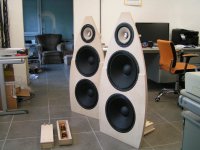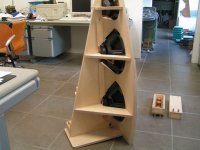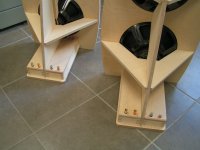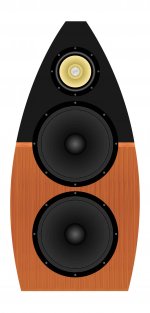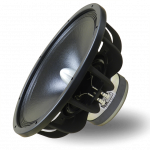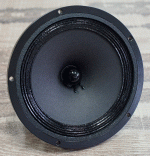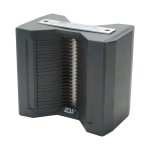Hi BarG01,
It is based on one Tangband W8-2145 8" full range driver:
W8-2145 - 8" Paper Full Range - TB SPEAKER CO., LTD.
And two Eminence Alpha 15A:
https://www.eminence.com/pdf/Alpha_15A.pdf
Crossover filter:
W8-2145 (no filtering).
2 x Eminence Alpha 15A in parallel, 4.7mH choke.
This crossover filter was designed for use with the PowerDAC.
Impedance 2.67 ... 8 Ohm.
Crossover frequency (bass) 135 Hz.
Sensitivity: 90dB.
Height: 122 cm
Width: 58cm
depth: 46cm
It is constructed from 12mm and 18mm plywood.
I attached pictures of the speaker construction. The boxes that hold 6th order Linkwitz Riley low / hi pass filters are no longer required.
We plan to offer these open baffle speakers for use with our PowerDACs. These speakers will be introduced together with the PowerDAC, introduction is planned for late 2021.
May we get some info about your open baffle speakers if they are not proprietary design? Are there any description of them anywhere?
It is based on one Tangband W8-2145 8" full range driver:
W8-2145 - 8" Paper Full Range - TB SPEAKER CO., LTD.
And two Eminence Alpha 15A:
https://www.eminence.com/pdf/Alpha_15A.pdf
Crossover filter:
W8-2145 (no filtering).
2 x Eminence Alpha 15A in parallel, 4.7mH choke.
This crossover filter was designed for use with the PowerDAC.
Impedance 2.67 ... 8 Ohm.
Crossover frequency (bass) 135 Hz.
Sensitivity: 90dB.
Height: 122 cm
Width: 58cm
depth: 46cm
It is constructed from 12mm and 18mm plywood.
I attached pictures of the speaker construction. The boxes that hold 6th order Linkwitz Riley low / hi pass filters are no longer required.
We plan to offer these open baffle speakers for use with our PowerDACs. These speakers will be introduced together with the PowerDAC, introduction is planned for late 2021.
Attachments
Do you know how well the new fractal DAC architecture fares in its measured performance (THD+N, IMD) ?Hi andrea,
Yes, gate drivers (4.5A peak drive current, cross conduction protection, level translation) + suitable MOSFET H-bridges.
The Fractal D/A converter is entirely different from (segmented) R2R ladder DACs, this made the PowerDAC concept possible. I tried the PowerDAC concept in the past (using R2R) and had to give up on this too.
There was some measurements of the older MOS DACs on SBAF and the measurements were a little disappointing but im hoping this was improved upon with fractal.
Hi andrea,
Yes, gate drivers (4.5A peak drive current, cross conduction protection, level translation) + suitable MOSFET H-bridges.
The Fractal D/A converter is entirely different from (segmented) R2R ladder DACs, this made the PowerDAC concept possible. I tried the PowerDAC concept in the past (using R2R) and had to give up on this too.
Hi John,
I don't know anything about your fractal DAC so I cannot argue, but the H bridge configuration suffers the same issues of a complementary pair in a R2R ladder: all the mosfets will never switch at the same time, that means huge current spikes (several amperes) on the power rail, and this inevitably generates unwanted noise.
I have thought to drive each gate separately nulling the delay with an FPGA, but this complicates a bit the design and mostly it injects jitter in the switches. And the H bridge configuration is more complex to cure than a mosfet pair.
How did you solve this issue (obviously if you want share your solution)?
Hi BarG01,
It is based on one Tangband W8-2145 8" full range driver:
W8-2145 - 8" Paper Full Range - TB SPEAKER CO., LTD.
And two Eminence Alpha 15A:
https://www.eminence.com/pdf/Alpha_15A.pdf
Crossover filter:
W8-2145 (no filtering).
2 x Eminence Alpha 15A in parallel, 4.7mH choke.
This crossover filter was designed for use with the PowerDAC.
Impedance 2.67 ... 8 Ohm.
Crossover frequency (bass) 135 Hz.
Sensitivity: 90dB.
Height: 122 cm
Width: 58cm
depth: 46cm
It is constructed from 12mm and 18mm plywood.
I attached pictures of the speaker construction. The boxes that hold 6th order Linkwitz Riley low / hi pass filters are no longer required.
We plan to offer these open baffle speakers for use with our PowerDACs. These speakers will be introduced together with the PowerDAC, introduction is planned for late 2021.
It's very similar to the speaker system I'm building, if ever I will find the time to finish it.
A couple of 15" driver for the bass section, the AE LO15. Then a fullrange driver, the Supravox 165 GMF. And finally the Great Heil to refine the high section.
The sensitivity is around 97 dB.
I use a minimal crossover although very different from yours. The AE drivers operates up to around 100 Hz, but I cut them with acoustical filter rather than electric. Then a single series capacitor for the Supravox to avoid very low frequencies that only generate distortion. Again there is an acoustical filter at about 7 kHz for the fullrange. Finally a single capacitor for the AMT driver that could be damaged by high escursion.
After years of listening I believe that the Open Baffle is the only way to get realistic sound.
Attachments
Supravox better than the chineese L CAO alnico or the EMS-speakers ?
I surmise the open bafle is very widthy to have a so low cut-off and the overlapp between the bass and the little 165 from Supravox (which has no a big x-max by design) : many good testimonials about the Supravox but many finally given up it for compression driver + mid-bass horn. But the EMS-speaker driversare very special (very clear). No look at PHL Audio with higher X-Max ?
I surmise the open bafle is very widthy to have a so low cut-off and the overlapp between the bass and the little 165 from Supravox (which has no a big x-max by design) : many good testimonials about the Supravox but many finally given up it for compression driver + mid-bass horn. But the EMS-speaker driversare very special (very clear). No look at PHL Audio with higher X-Max ?
Last edited:
...My aim was not attempting to improve the analogue signal path (interlinks, (pre) amps) but simply throwing it out completely. This will also eliminate all related problems, distortion and degrading....
Hurray!!!
Where can one know more about this power dac?
//
Supravox better than the chineese L CAO alnico or the EMS-speakers ?
I surmise the open bafle is very widthy to have a so low cut-off and the overlapp between the bass and the little 165 from Supravox (which has no a big x-max by design) : many good testimonials about the Supravox but many finally given up it for compression driver + mid-bass horn. But the EMS-speaker driversare very special (very clear). No look at PHL Audio with higher X-Max ?
The Supravox 165 GMF has very nice mid, one of the best I ever heard. It's more linear than the L CAO, while I have never listen to the EMS drivers.
The baffle will be enough wide but the excursion of the Supravox will be limited by a high pass filter with a single capacitor. I think to cross it at around 100 Hz, but the best crossover frequency will be experimentally derived.
Yes Andrea, I agree this particular Supravox (and the 16") has something quite nice. Papers cone from PHL seems better though but mayve not as FR than the 165 GMF. I believe the new Fertins with EMS-Speaker to be a little above old SUPRAVOX -mms very low that causes break-ups in FR which they are made for -
think if you HP with a single cap you should have to cut-off high and it will suffer more with the natutal acoustic short of OB in these frequencies. SO certainly the bass driver must overlap and be a little Linkwitz-transform helped.
ok. Sorry John for the little disgress.
think if you HP with a single cap you should have to cut-off high and it will suffer more with the natutal acoustic short of OB in these frequencies. SO certainly the bass driver must overlap and be a little Linkwitz-transform helped.
ok. Sorry John for the little disgress.
Last edited:
The Supravox 165 GMF has very nice mid, one of the best I ever heard. It's more linear than the L CAO, while I have never listen to the EMS drivers.
The baffle will be enough wide but the excursion of the Supravox will be limited by a high pass filter with a single capacitor. I think to cross it at around 100 Hz, but the best crossover frequency will be experimentally derived.
Hi Andrea,
Interesting project. Are you sharing the progress of this OB design by any chance on another thread? Thanks
I have not yet started a thread because now I have no time to finish the construction, the drivers are still in their boxes.
Too projects to be completed at the moment, I will start a dedicated thread but now I don't know when it will become possible.
Okay thanks Andrea [emoji4]
Hi matthiasw,
The very best performing S/PDIF receiver we found (we thoroughly tested & tweaked all popular S/PDIF receivers over and over again) was the DIR9001 with a tweaked loop filter and in combination with the ElectroTos low jitter protocol. The DIR9001 supports 96 KHz maximum.
Higher sample rates require higher clock and data rates in source, interlink and DAC circuits. Circuits are never perfect, the major issues with digital audio are stray capacitances and stray inductances in source, interlink and DAC. The combination of high frequency clock and data rates with these parasitics will cause major issues with digital audio that are still not fixed. One of the results is source dependency (every bit-perfect source still sounds different). When clearly audible source dependency occurs, digital audio is still far from optimal.
Every imaginable interference that is added to the always present digital audio related signals will make matters worse, think of (RF) ground loop noise and power supply (mains) noise. All data and frequency signals will crosstalk and create one big unpredictable interference spectrum that can reach into the GHz range (harmonics). Even Bluetooth, GSM and WIFI add to this mix. This complex and constantly varying large bandwidth spectrum will be de-modulated by P-N junctions for example (think of radio receivers). Then demodulation products can be formed from two or more inaudible frequencies that will now fall within the audio spectrum (same happens with radio, television and wireless phones, but here this is desired to get the information across).
This interference cannot be blocked by 20KHz brickwall filters because these frequencies fall within the audio spectrum itself. The result is audible degrading / change of sound even when using world's best synchronous re-clockers in a DAC.
This is the major (not the only) reason that bit-perfect sources still sound different with DACs that should technically be close to perfection. Source dependency is noticed by many audiophiles and the most hilarious fixes are used like audiophile LAN switches and filtering equipment that is more expensive than the digital audio set.
But it gets even much worse. Analogue audio was never perfect either, every amplifier (driven by an analogue audio source) sounds different. No analogue amplifier sounds or will ever sound the same and or perfect. There are too many variables to keep under control and there are fundamental problems with analogue signal processing that are not even discovered. I think of analogue audio circuits as non-linear circuits.
Now mix imperfect digital audio and imperfect analogue audio and one created one huge problem that is never going to be fixed. Think of digital and analogue as water and fire, these will never mix well.
Chances of success are a bit higher when going all analogue (tape / vinyl + analogue (pre) amplifiers) or all digital (no active analogue circuits allowed, only digital on/off switches).
So I personally arrived at the conclusion that the conventional digital audio setup with a digital audio source, DAC and (pre) amplifier will always be doomed to fail. Recently I gave up on (pre) amps combined with digital audio equipment and developed an alternative that might trigger a revolution in top performance digital audio. More on this later.
We offer the UPL96ETL and U192ETL. After some time it became very clear that the UPL96ETL USB-memory-stick based player simply performs a lot better than the U192ETL, understandable, that's why we developed it in the first place, because of the never ending issues with USB audio. We still offer the U192ETL because most audiophiles prefer USB audio streaming and take related degrading for granted.
I was asked if I could give it another try and slightly improve the U192ETL so it comes closer to our UPL96ETL reference player. The U192ETL is an XMOS-based USB receiver with asynchronous feedback and master clocks that have better phase noise specs compared to the popular Crystek CCHD-759 clocks. We use a 8-core XMOS (XU208). Such configuration can be found in many audiophile DACs and this is perhaps the best performing solution for USB audio streaming, but it still fails to match UPL96ETL, SD-card players or even audiophile CD transports.
The irony is that both, UPL96ETL and U192ETL use exactly the same master clocks, same USB bus power supply, same USB interface and same synchronous re-clocker circuits. Find the 10 differences .......
Logically speaking it -should- be possible to get very similar performance from very similar circuits. So I was determined to pinpoint this decades old issue with USB audio and fix it once and for all.
After systematically testing -all- possible causes over and over again, one issue remained, this simply had to be it. I even mentioned this problem on this thread multiple times ... I should have known. The fix was a different matter, it basically boils down to blocking noise, but how?
I tried most popular digital isolators, opto-couplers constructed with Toslink transmitters and receivers. Nothing worked, only made matters worse. The theoretical galvanically insulated approach with master clocks on the other side of this barrier (feeding clocks back to the XMOS using a digital coupler) also failed miserably. For a while it seemed that this issue cannot be fixed and we simply have to live with the clearly degraded sound (compared to the reference) of USB audio.
After many sleepless nights I came up with one other option and this one finally worked, it fixed the USB issue. Not only that, when applied to the UPL96ETL reference, even that reference improved significantly. Now both, UPL96ETL and U192ETL perform on a virtually similar level. Sure there will still be small audible differences, nothing is perfect, but when these are very difficult to hear or cannot be heard at all by direct comparison with a reference, it is more than good enough.
Our listening test setups:
Macbook -> USB (UC250 interlink) -> Fractal PowerDAC -> 90dB Open baffle speakers (no analogue signal path, all digital).
Macbook -> USB (UC250 interlink) -> Modified DA96ETF (187.5 Ohm output impedance) -> SVC24 shunt volume control -> Beyerdynamic DT990-pro studio headphones (250 Ohm).
Macbook -> USB (UC250 interlink) -> DA96ETF -> SVC24 -> servo power amps -> 90dB Open baffle speakers.
We used unfiltered mains power supply, WIFI, Bluetooth all switched-off. No smartphones anywhere near the test setup.
We used Swinsian application
Swinsian — The Advanced Mac Music Player
We tested 44.1, 48, 88.2 and 96 KHz files.
We played all different kind of genres and different recording quality. Above systems make it very easy to hear big differences in recording quality and the highly destructive impact of DSP on already mastered audio files.
After getting annoyed with the flimsy USB interlinks with poor shielding and super thin wiring I decided to construct a better option. I use individually shielded data and power wiring pairs and thick wire with low DC resistance so I get a decent power supply at the USB receiver (reduced voltage drop / reduced load induced ripple voltage) and more reliable data transfer over larger distances. Note that with USB audio streaming, data transmission errors cannot be corrected. The individually shielded wire pairs minimise unwanted crosstalk between both, USB bus power wire pairs and USB data wire pairs.
I attached a picture of cable construction
So this is the reason you limit the DAC's to 96khz .
Have you not found a way to circumvent the DIR9001 as it seems this bottlenecks and limits all performance of a DAC .
Hi matthiasw,
The very best performing S/PDIF receiver we found (we thoroughly tested & tweaked all popular S/PDIF receivers over and over again) was the DIR9001 with a tweaked loop filter and in combination with the ElectroTos low jitter protocol. The DIR9001 supports 96 KHz maximum.
Hi ecdesigns,
what do you think about to get completely rid of S/PDIF and develop a device similar to the MSB PRO USB:
Pro USB Adapter - MSB Technology
This device is also USB bus powered.
Thank you
Matt
Last edited:
Just the way I have suggested in post #7686
Building the ultimate NOS DAC using TDA1541A
except for the synchronous mode.
Using a FIFO all the sources including USB can work asynchronously.
The goal is slaving the FIFO to the clock of the DAC, namely to a SOTA oscillator.
Building the ultimate NOS DAC using TDA1541A
except for the synchronous mode.
Using a FIFO all the sources including USB can work asynchronously.
The goal is slaving the FIFO to the clock of the DAC, namely to a SOTA oscillator.
Hi andrea,
Jitter could be compared to a virus, once it has spread, it is no longer containable, regardless of the methods used, game over.
When attempting to block jitter in a DAC, the jitter has already spread all over the place .... game over.
Using a FIFO all the sources including USB can work asynchronously.
The goal is slaving the FIFO to the clock of the DAC, namely to a SOTA oscillator.
Jitter could be compared to a virus, once it has spread, it is no longer containable, regardless of the methods used, game over.
When attempting to block jitter in a DAC, the jitter has already spread all over the place .... game over.
So this is the reason you limit the DAC's to 96khz .
Have you not found a way to circumvent the DIR9001 as it seems this bottlenecks and limits all performance of a DAC .
Having heard the new EC designs U192 and Fractal DAC with ElectroTos there is no sense of any limitation or bottleneck. The way this combo renders music has to be heard.
Hi andrea,
Jitter could be compared to a virus, once it has spread, it is no longer containable, regardless of the methods used, game over.
When attempting to block jitter in a DAC, the jitter has already spread all over the place .... game over.
It's not true, please read accurately my post #7686 and then tell me how the jitter of the source can affect the DAC.
The LRCK is fully isolated from the source, it comes directly from the dividers via copper, so the only jitter that affects the DAC comes from the oscillators/dividers.
I have already published the phase noise plot of the best oscillator ever for digital audio, that doesn't add any jitter to the DAC.
The high jitter of BCK and DATA can be neglected because they does not affects the DAC timing.
And no EMI/RFI can reach the DAC from BCK and DATA because the optic fiber is a real brick wall.
The only issue is that such this way is a little expensive.
Hi matthiasw,
I tried that before, many times, absolutely convinced that direct I2S interface is the best way to go. I tried every practical isolator and every practical way of combining master clocks & FIFO re-clocker.
The end result of these exhaustive tests is the ElectroTos interface and the ElectroTos low jitter protocol.
I will list its advantages again:
- Perfect galvanic insulation (LED -> Toslink optical receiver, very low coupling capacitance).
- Low jitter (coaxial interlink, unique low jitter protocol).
- Extra jitter reduction inside the DAC with modified PLL.
- Fewest practical signal changes to transmit a given amount of data (minimum data bandwidth required, lowest switching noise energy).
- Band-limited output (20MHz, greatly reduced noise injection, greatly reduced issues with parasitics inside the DAC circuits).
- Jitter / noise is tackled -before- the signal is routed to the DAC, this way it can't spread.
The problem with S/PDIF coaxial interfaces:
- Ground loop noise injection (insulation transformers have high input-output coupling capacitance).
- Unlimited data bandwidth (maximum noise injection).
- Protocol promotes high jitter.
The Problem with Toslink interfaces:
- High jitter
- Issues with reflections (optical).
- Protocol promotes high jitter.
The problem with USB interfaces:
- Unlimited data bandwidth (maximum noise injection).
- (RF) ground loop noise.
- Not designed for digital audio, highly problematic.
The problem with I2S interfaces:
- Unlimited data bandwidth (maximum noise injection).
- (RF) ground loop noise.
- Not designed for external DACs, only chip to chip communication. I2S stands for Inter-IC Sound.
what do you think about to get completely rid of S/PDIF and develop a device similar to the MSB PRO USB:
I tried that before, many times, absolutely convinced that direct I2S interface is the best way to go. I tried every practical isolator and every practical way of combining master clocks & FIFO re-clocker.
The end result of these exhaustive tests is the ElectroTos interface and the ElectroTos low jitter protocol.
I will list its advantages again:
- Perfect galvanic insulation (LED -> Toslink optical receiver, very low coupling capacitance).
- Low jitter (coaxial interlink, unique low jitter protocol).
- Extra jitter reduction inside the DAC with modified PLL.
- Fewest practical signal changes to transmit a given amount of data (minimum data bandwidth required, lowest switching noise energy).
- Band-limited output (20MHz, greatly reduced noise injection, greatly reduced issues with parasitics inside the DAC circuits).
- Jitter / noise is tackled -before- the signal is routed to the DAC, this way it can't spread.
The problem with S/PDIF coaxial interfaces:
- Ground loop noise injection (insulation transformers have high input-output coupling capacitance).
- Unlimited data bandwidth (maximum noise injection).
- Protocol promotes high jitter.
The Problem with Toslink interfaces:
- High jitter
- Issues with reflections (optical).
- Protocol promotes high jitter.
The problem with USB interfaces:
- Unlimited data bandwidth (maximum noise injection).
- (RF) ground loop noise.
- Not designed for digital audio, highly problematic.
The problem with I2S interfaces:
- Unlimited data bandwidth (maximum noise injection).
- (RF) ground loop noise.
- Not designed for external DACs, only chip to chip communication. I2S stands for Inter-IC Sound.
Looks like an hybrid between the Bufallo teleporter device and what we can see everywhere with ime filtering and isolator chips... nothing special imho reading the link but one has to test in to really know of course.Hi ecdesigns,
what do you think about to get completely rid of S/PDIF and develop a device similar to the MSB PRO USB:
Pro USB Adapter - MSB Technology
This device is also USB bus powered.
Thank you
Matt
Hi matthiasw,
I tried that before, many times, absolutely convinced that direct I2S interface is the best way to go. I tried every practical isolator and every practical way of combining master clocks & FIFO re-clocker.
The end result of these exhaustive tests is the ElectroTos interface and the ElectroTos low jitter protocol.
Hi ecdesigns,
thank you for your patience answering my questions.
Please be so kind to comment on my post #7697.
Is it possible to launch a PowerDAC version with an output of say 25W per channel?
Thank you
Matt
Last edited:
- Home
- Source & Line
- Digital Line Level
- Building the ultimate NOS DAC using TDA1541A
